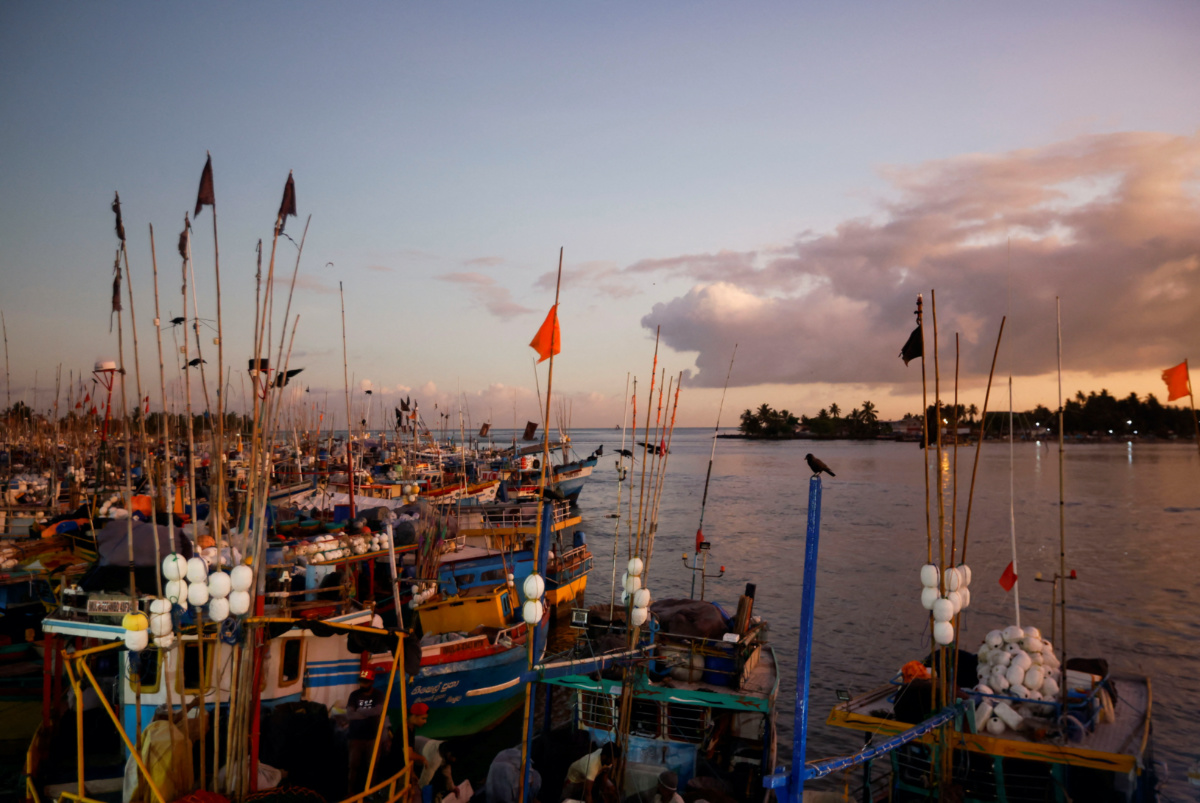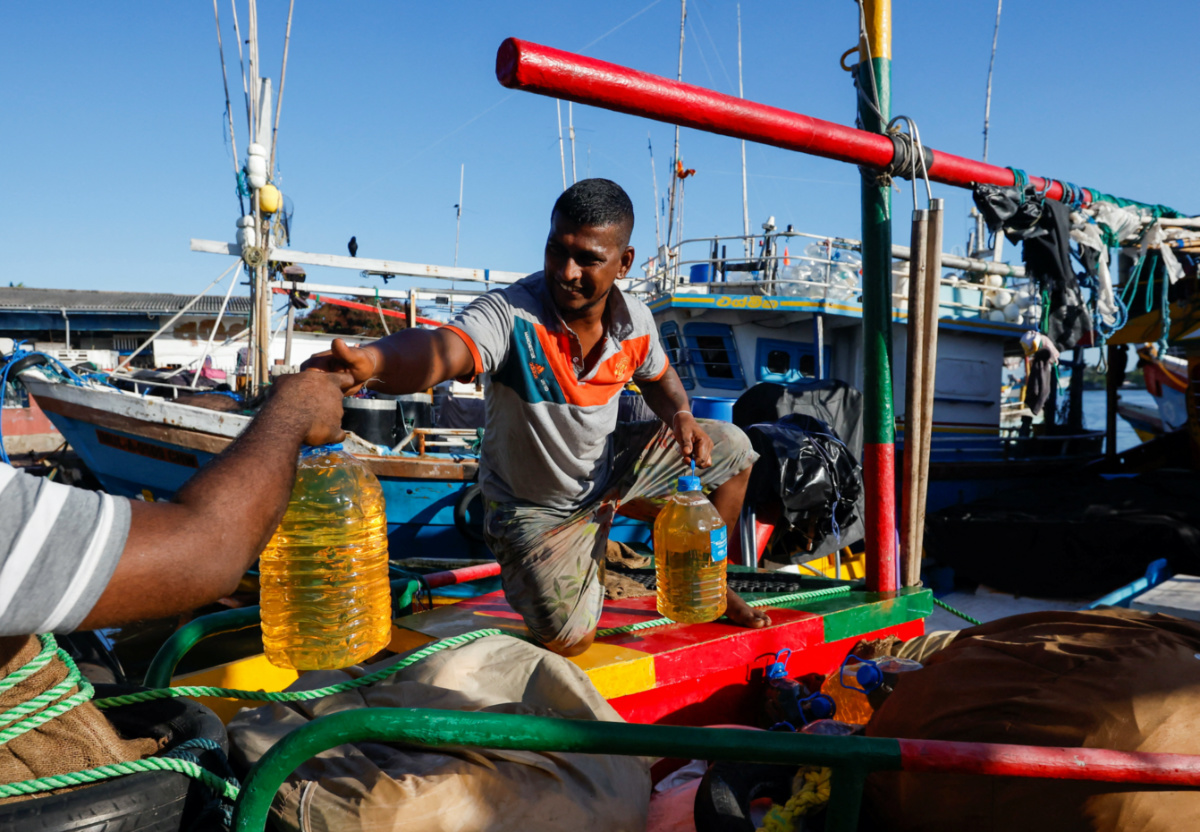Negombo, Sri Lanka
Reuters
After three weeks at sea, Anton Fernando tallies his sales of tuna and other fish on a dock in Negombo, a fishing town in Sri Lanka, where the country’s financial crisis darkens already murky waters.
The math does not look good for Fernando and his crew of four among the dozen gently bobbing trawlers. Each takes home 40,000 Sri Lankan rupees ($US130) from their gruelling expedition.
“This will not be enough to cover their household expenses,” Fernando, 44, told Reuters, holding up a notebook scribbled with numbers. “Even before we go home, we know this isn’t enough to cover electricity and water bills, tuition fees and food.”

A general view of fishing trawlers parked at Negombo’s “Lellama” fishery harbour during the sunrise, as fishermen and their families struggle due to a lack of diesel and a price hike over the last few months amid the country’s economic crisis, in Negombo, Sri Lanka, on 16th April. PICTURE: Reuters/Navesh Chitrakar.
The island nation of 22 million people off the southern tip of India is battling its worst financial crisis since independence in 1948, as COVID-19, mismanaged government finances and ill-timed tax cuts sap dwindling foreign reserves.
Last week the central bank said it was suspending repayment on some of its foreign debt pending a restructure.
SRI LANKA PM OFFERS PROTESTERS TALKS AS OPPOSITION EYES NO-CONFIDENCE VOTE; ONE DEAD, SEVERAL INJURED IN PROTESTS
Sri Lanka’s Prime Minister offered talks on Wednesday with protesters calling for the government to step down over its handling of an economic crisis as the opposition threatened to bring a no-confidence motion against it in parliament.
The island nation of 22 million people is in the throes of its worst financial crisis since independence in 1948, with a foreign currency shortage stalling imports of fuel and medicines and bringing hours of power cuts a day.
Thousands of people have taken to the streets, many staging a sit-in in the commercial capital, Colombo, to denounce the government led by President Gotabaya Rajapaksa and his elder brother, Prime Minister Mahinda Rajapaksa.
At least one person was killed and over a dozen injured after protesters clashed with police in the central town of Rambukkana, a doctor told Reuters, the first fatality since demonstrations began in the crisis-hit country weeks ago.
“Fifteen people who were injured in the incident were brought to the hospital and three are in critical condition having sustained quite severe injuries to their abdomen region,” a doctor at the state-run Kegalle Hospital told Reuters.
“One person died after being admitted,” the doctor said, declining to be named as he is not authorised to speak to media.
The Prime Minister’s office, meanwhile, said that the Prime Minister was “ready to start talks with the protesters at Galle Face Green”, in a statement referring to a protest site that has become the focus of discontent.
“If protesters are ready to discuss their proposals to resolve the challenges currently facing the nation, then the Prime Minister is ready to invite their representatives for talks,” the office said.
Some of the protesters at the tent encampment, which has been growing over recent days with food stalls, medical facilities and phone charging stations, said this week they would only leave if the Rajapaksas stepped down.
Sri Lanka is due to begin negotiations with the International Monetary Fund next week for a loan programme, after months of delay as the crisis worsened.
Multiple ratings agencies on Wednesday downgraded Sri Lanka’s sovereign rating, citing the economic crisis in the country and rising external funding pressures.
Fitch also downgraded Sri Lanka’s foreign-currency rating and said the move reflects its view that a sovereign default process has begun.
“Sri Lanka’s debt restructuring process is likely to be complicated and may take months to complete,” S&P Global said in a statement.
Earlier on Wednesday, the World Bank revised Sri Lanka’s growth estimates to 2.4 per cent from 2.1 per cent earlier, but warned that the economic outlook continues to remain uncertain.
In the commercial capital Colombo, protesters crowd the streets demanding the ouster of President Gotabaya Rajapaksa as people deal with skyrocketing prices, prolonged power cuts and shortages of medicine, fuel and other items.
In Negombo, the fisherman struggle to stay afloat.
Fishing makes up just 1.3 per cent of the South-East Asian nation’s economy, but it employs one-tenth of its people and helps feed far more. The island exports tuna, swordfish, crabs, lobsters and prawns to a dozen countries including the United States, Britain, China and Japan, accounting for eight per cent of its agricultural exports.
Sri Lanka’s fisheries and finance ministries did not immediately respond to emailed requests for comment on measures taken to help the fishing industry.
Some fishermen say they have cut back on food, others have stopped repaying loans. All of those who spoke to Reuters say they constantly scrounge for fuel for their boats and their homes.
“Focus is to live today”
In Negombo, a tight-knit fishing community 40 kilometres from Colombo, workers pull fish from docked boats, weigh them and pile them into a handful of refrigerated trucks.
Each trip for Fernando’s colourful St Anne 2 trawler requires at least 1,000 litres of diesel and several hundred kilograms of ice.
“We have to stand in line for hours to get fuel and even then we are not sure if we will get enough. Ice, bait, nets, everything we need has increased in price,” he said. “Many boats have stopped going out to sea entirely because of the fuel issue.”
Two fishermen with small boats said they siphon petrol from friends’ and neighbours’ motorcycles because fuel stations refuse to fill their jerry cans.
Finance Minister Ali Sabry told Reuters this month the government’s first priority was to restore essentials such as fuel. He said some of the aid the government is seeking from lenders like the International Monetary Fund would go to the country’s economically vulnerable populations.
“Fishermen don’t know how they will get fuel or how they will manage high food costs,” said Herman Kumara, head of the National Fisheries Solidarity Movement that represents some 9,000 fisherman. “Their only focus is to live today.”
The crisis has grounded at least half the area’s trawler fleet, he said, predicting “a life-and-death situation here over the next three to six months”.

A man gives a bottle of fuel to his friend from a fishing trawler parked at Negombo’s “Lellama” fishery harbour, as fishermen and their families struggle due to a lack of diesel and a price hike over the last few months amid the country’s economic crisis, in Negombo, Sri Lanka, on 16th April. PICTURE: Reuters/Navesh Chitrakar.
Mary Dilani said she makes 1,500 rupees a day drying fish at a nearby beach, while her husband GK Chaminda, who borrowed 100,000 rupees three years ago for a small rowing boat and now struggles to repay the loan, makes 2,000 rupees.
“We cannot afford cooking gas anymore,” she said in their small, two-room house by a plastic-strewn beach in Negombo’s Sea Street neighbourhood, where they live with their two daughters and granddaughter. “I have switched to a kerosene stove but sometimes we cannot find kerosene.”
The family’s biggest worry is finding 4,000 rupees for textbooks for a daughter about to start the new school year.
“Life has become very hard,” Dilani said.






